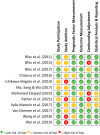Prognostic factors for the development of incontinence-associated dermatitis (IAD): A systematic review
- PMID: 39016196
- PMCID: PMC11253026
- DOI: 10.1111/iwj.14962
Prognostic factors for the development of incontinence-associated dermatitis (IAD): A systematic review
Abstract
Incontinence-associated dermatitis (IAD) is an irritant contact dermatitis from prolonged contact with urine or faeces, which can significantly impact patient comfort and quality of life. The identification of prognostic factors for the development of IAD has the potential to enhance management, support preventive measures and guide future research. The objective of this systematic review was to summarize the empirical evidence of prognostic factors for the development of IAD. This study included prospective and retrospective observational studies or clinical trials that described prognostic factors associated with IAD. There were no restrictions on setting, time, language, participants or geographical regions. Exclusion criteria included reviews, editorials, commentaries, methodological articles, letters to the editor, cross-sectional and case-control studies, and case reports. Searches were conducted from inception to April 2024 on MEDLINE, CINAHL, EMBASE and the Cochrane Library. The studies were assessed by two independent reviewers using the QUIPS and the CHARMS-PF for data extraction. A narrative synthesis approach was employed due to study heterogeneity and using the 'vote counting based on direction' method and the sign test. The overall certainty of evidence was assessed using adapted GRADE criteria. The review included 12 studies and identified 15 potential predictors. Moderate-quality evidence suggests that increased stool frequency, limited mobility and friction/shear problems are risk factors for IAD development. Female sex, older age, vasopressor use and loose/liquid stool are risk factors supported by low-quality evidence. Increased stool frequency, limited mobility and friction/shear problems seem to be risk factors for the development of IAD. There is insufficient evidence to support the predictive validity of female sex, older age, loose/liquid stool and vasopressor use. There is substantial methodological variability across studies, making it challenging to make comparisons. Large-scale cohort studies in different settings that incorporate our review findings should be conducted in the future.
Keywords: dermatitis; faecal incontinence; prognosis; risk factors; urinary incontinence.
© 2024 The Author(s). International Wound Journal published by Medicalhelplines.com Inc and John Wiley & Sons Ltd.
Conflict of interest statement
The authors declare that they have no conflict of interest.
Figures
References
-
- Beeckman D, Campbell J, Campbell K, et al. Proceedings of the Global IAD Expert Panel. Incontinence associated dermatitis: moving prevention forward. Wounds International 2015.
-
- World Health Organization (WHO) . International classification of diseases for mortality and morbidity statistics (11th Revision). 2018. Accessed January 9, 2023. https://icd.who.int/browse11/l-m/en
-
- Demarre L, Verhaeghe S, Van Hecke A, Clays E, Grypdonck M, Beeckman D. Factors predicting the development of pressure ulcers in an at‐risk population who receive standardized preventive care: secondary analyses of a multicentre randomised controlled trial. J Adv Nurs. 2015;71(2):391‐403. - PubMed
-
- Van Damme N, Vanryckeghem E, Verhaeghe S, Beeckman D. Incontinence‐associated dermatitis in elderly: a qualitative phenomenological study on patient experiences. 18th Annual Meeting of the European Pressure Ulcer Advisory Panel (EPUAP 2015); Ghent, Belgium. European Pressure Ulcer Advisory Panel, 18th Annual Meeting, Abstracts: EPUAP Business Office; 2015. p. 65.
Publication types
MeSH terms
Grants and funding
LinkOut - more resources
Full Text Sources
Medical
Miscellaneous



